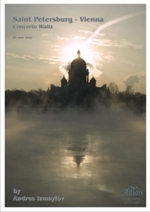 |
|||
| |
of Harp Music |
| © 2004-2025 ADLAIS |
| Saint
Petersburg - Vienna Concerto Waltz Andres Izmaylov (b. 1974) |
return to previous page |
 |
Work: | Single work for solo harp |
| Catalogue No: | Adlais 145 | |
| ISMN: | 979-0-57032-117-9 | |
| Edition: | 2007 A4 stapled | |
| Duration: | c. 3' 30" minutes | |
| Suitable for: | Grade 7-8 Pedal Harp | |
| Price:: | £8.00 Go to shop | |
| See all Adlais Publications by Andres Izmaylov | ||
Saint Petersburg-Vienna Concerto-Waltz celebrates
the link, via the Waltz, between two of the greatest musical cities of
the nineteenth century.
The Viennese waltz is the oldest of all ballroom dances. The charm, elegance,
vivacity and sophistication of this music mirrored the glitter and the joie de
vivre of old Vienna, and by the mid-nineteenth century its lilting strains and
its magic had swept all over the continent. In 1814-15, the Congress of Vienna
had re-organised Europe in the aftermath of the Napoleonic wars, and Europe,
in its turn, had been conquered by the waltz.
Then came the railways. One hundred and seventy years ago the first railway in Russia was built to link St Petersburg with Pavlovsk, site of the royal palace, and the railway station with its magnificent terminal building, known as the Vokzal, was opened on 10 October 1837. Early musical ensembles invited to play there included the band directed by Franz Gung'l (1845-48) and afterwards by Josef Gung'l, who (with Zabel as harpist) played the summer season between 1850 and 1855.
From 6 May 1856, with his 26-man orchestra, Johann Strauss Junior, 'The Waltz King', spent eleven summers entertaining St Petersburg high society at Pavlovsk's 'musical train station'; thus were consolidated the links with Vienna already established in 1852, when Strauss had composed his Grossfürsten Marsch (op. 107) to celebrate the visit of Tsar Nicholas and his sons to the city. Idolised by the Russian public, Strauss achieved pop-star fame, and many of his most enduringly famous compositions date from these visits to Pavlovsk, including the Tritsch-Tratsch Polka and the Pizzicato Polka. Such works as the Pavlovsk Polka and the Faust-Quadrille were published only in Russia, whilst his waltzes 'Viennese Bonbons' and 'Parting with St Petersburg' were inspired by his love for Olga Smimitskaya, a St Petersburg aristocrat. It is the Waltz King who can also be credited with drawing attention to the genius of Tschaikovsky, whose 'Characteristic Dances' he introduced to the public in 1865.
Together with his brother Josef, Johann Strauss undertook his final Pavlovsk concert in 1869, whilst performances in 1886 at St Petersburg and Moscow, and a single concert at Pavlovsk marked his last visits to Russia. His creative baton was passed on to Mikhail Glinka, whose concerts continued the tradition. In 2003, on the occasion of the 300th anniversary of St Petersburg, the Austrian consulate presented the city with a copy of the famous sculpture of Strauss by Edmund Hellmer that used to stand in Vienna's Stadtpark, and appropriately enough, the statue is now one of the features of Pavlovsk.
At the turn of the 21st century, the tradition of summer music seasons which was interrupted in 1917 has been resumed. A sixth Grand Waltz Festival held in St Petersburg in July 2007 and a Russian Ball in the historic Hofburg Palace in Vienna in January 2008 consolidate these links. The aim of these new international projects is to resume and develop cultural dialogue between Russia and Austria, and particularly between St Petersburg and Vienna. Andres Izmaylov's Concerto-Waltz, St Petersburg-Vienna provides a delightful link for the harp in this cultural musical chain.
© A.G. 2007
Saint Petersburg - Vienna Concerto Waltz performed by Andres Izmaylov |


